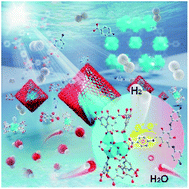A new strategy for constructing covalently connected MOF@COF core–shell heterostructures for enhanced photocatalytic hydrogen evolution†
Abstract
Combining the advantages of porosity and crystallinity of MOF and COF photocatalysts to build a covalently connected MOF–COF hybrid heterostructure has been proved to be an effective way to assemble efficient photocatalysts. However, until now, only MOFs with –NH2 groups in the ligand have been used to build covalently connected MOF–COF hybrid materials by a Schiff base reaction between the components. In this work, we develop a new strategy for constructing covalently connected MOF–COF hybrid materials by post-synthetic modification of metal nodes with MOFs without –NH2 in the ligand. A typical Zr-MOF without –NH2 ligands, MOF-808, was modified by coordination with p-aminobenzoic acid on Zr6 clusters to graft it with –NH2 groups. Then, the core–shell MOF-808@TpPa-1-COF with a covalent linkage between the two components was synthesized by an in situ reaction. The core–shell morphology of the hybrid material and the covalent linkage between the components were confirmed by various characterizations. The results of photocatalytic hydrogen evolution under visible light irradiation confirm that MOF-808@TpPa-1-COF (6/4) shows a hydrogen evolution rate of 11.88 mmol g−1 h−1, which is 5.6 times higher than that of the parent TpPa-1-COF. Further investigations confirm the significant role of the covalent linkage between the components in the efficient separation and transfer of photogenerated electrons in the photocatalytic hydrogen evolution reaction. The strategy of assembling MOF@COF in this work could be applied for constructing more covalently linked MOF–COF hybrid materials with the desired morphology and function.



 Please wait while we load your content...
Please wait while we load your content...